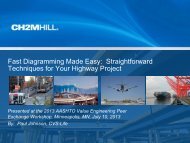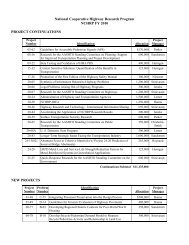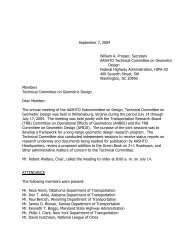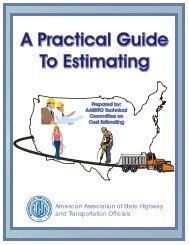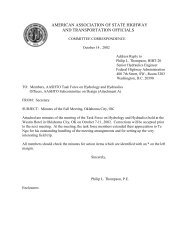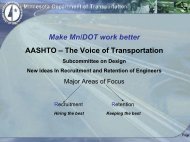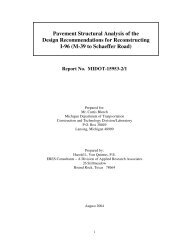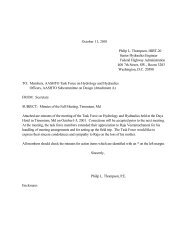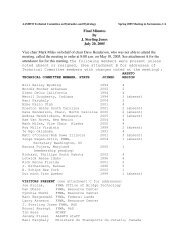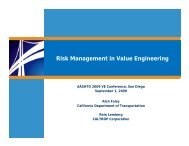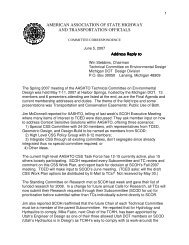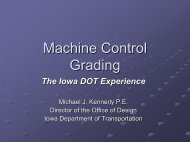AASHTO DARWin Task Force Development of DARWin-ME
AASHTO DARWin Task Force Development of DARWin-ME
AASHTO DARWin Task Force Development of DARWin-ME
Create successful ePaper yourself
Turn your PDF publications into a flip-book with our unique Google optimized e-Paper software.
<strong>AASHTO</strong> <strong>DARWin</strong> <strong>Task</strong><br />
<strong>Force</strong> <strong>Development</strong> <strong>of</strong><br />
<strong>DARWin</strong>-<strong>ME</strong>
Presentation Outline<br />
<strong>DARWin</strong> <strong>Task</strong> <strong>Force</strong><br />
Current s<strong>of</strong>tware status<br />
<strong>Development</strong> <strong>of</strong> <strong>DARWin</strong>-<strong>ME</strong><br />
Future enhancements/modules, etc.<br />
2
<strong>DARWin</strong> <strong>Task</strong> <strong>Force</strong> Members<br />
Linda Pierce (Chair), Washington<br />
Michael Pologruto, Vermont<br />
Trenton Clark, Virginia<br />
Andrew Johnson, South Carolina<br />
Three new members:<br />
Imad Basheer, California<br />
Laura Fenley, Wisconsin<br />
Julian Bendana, New York<br />
FHWA Liaison: Chris Wagner<br />
3
Current S<strong>of</strong>tware<br />
<strong>DARWin</strong> 3.1 is the latest s<strong>of</strong>tware version <strong>of</strong> the<br />
1993 edition <strong>of</strong> the <strong>AASHTO</strong> Guide for Design<br />
<strong>of</strong> Pavement Structures<br />
<strong>AASHTO</strong> Contractor<br />
Applied Research Associates, Inc.<br />
Sunset planned for 12 months following release<br />
<strong>of</strong> <strong>DARWin</strong>-<strong>ME</strong><br />
4
<strong>DARWin</strong>-<strong>ME</strong> <strong>DARWin</strong> <strong>ME</strong> <strong>Development</strong><br />
<strong>DARWin</strong> TF meeting in July 2007 to move<br />
forward<br />
ARA presentation on s<strong>of</strong>tware<br />
Transfer <strong>of</strong> intellectual property rights from<br />
NCHRP to <strong>AASHTO</strong><br />
Issues related to continuing work<br />
Help files (December 2007)<br />
5
<strong>DARWin</strong>-<strong>ME</strong> <strong>DARWin</strong> <strong>ME</strong> <strong>Development</strong><br />
Condition <strong>of</strong> Source Code (research grade s<strong>of</strong>tware)<br />
Lack <strong>of</strong> documentation<br />
Multiple programming languages<br />
Documentation not in English<br />
No overall system design document<br />
Solution: ARA proposal to develop s<strong>of</strong>tware design<br />
document<br />
Major components and how they work together<br />
Descriptions <strong>of</strong> functionality, inputs, outputs, programming<br />
languages, and interfaces<br />
6
<strong>DARWin</strong>-<strong>ME</strong> <strong>DARWin</strong> <strong>ME</strong> <strong>Development</strong><br />
Independent Source Code Review<br />
Potential source code documentation by ARA<br />
List <strong>of</strong> enhancements for <strong>DARWin</strong>-<strong>ME</strong><br />
Reviewed by <strong>DARWin</strong> <strong>Task</strong> <strong>Force</strong>, Lead States<br />
Group, and Panel 1-40<br />
Request for Information (RFI)<br />
Statement <strong>of</strong> Qualifications<br />
Non-binding cost estimates<br />
Identification <strong>of</strong> potential s<strong>of</strong>tware development firms<br />
7
<strong>DARWin</strong>-<strong>ME</strong> <strong>DARWin</strong> <strong>ME</strong> Project Solicitation<br />
Project Solicitation Proposal Package<br />
Combine resources to develop/enhance s<strong>of</strong>tware<br />
Provides business case for supporting <strong>DARWin</strong>-<strong>ME</strong><br />
production s<strong>of</strong>tware effort<br />
Funding commitments<br />
Cost for <strong>DARWin</strong>-<strong>ME</strong> will be based on:<br />
Items identified by <strong>DARWin</strong> <strong>Task</strong> <strong>Force</strong><br />
Independent source code review<br />
Joint Technical Committee on Pavements (JTCoP) input<br />
At least 10-12 agencies required to proceed<br />
8
<strong>DARWin</strong>-<strong>ME</strong> <strong>DARWin</strong> <strong>ME</strong> <strong>Development</strong><br />
Based on successful project solicitation:<br />
Appoint new <strong>DARWin</strong>-<strong>ME</strong> <strong>Task</strong> <strong>Force</strong> (5-7 members)<br />
Develop and issue Request for Proposals (RFP) to<br />
RFI respondents<br />
Select s<strong>of</strong>tware development contractor<br />
Begin development (15-18 month development cycle)<br />
9
<strong>DARWin</strong>-<strong>ME</strong> <strong>DARWin</strong> <strong>ME</strong> Funding<br />
Existing <strong>DARWin</strong> TF Funding and new<br />
development grant funds from <strong>AASHTO</strong><br />
Capitalization Fund contribution:<br />
System Design Document by ARA<br />
Independent Source Code Review<br />
Potential source code documentation<br />
Request for Information (RFI)<br />
Project Solicitation Proposal<br />
Likely $100K+ commitment by <strong>AASHTO</strong><br />
10
<strong>DARWin</strong>-<strong>ME</strong> <strong>DARWin</strong> <strong>ME</strong> Funding (cont.)<br />
Commitments through Project Solicitation<br />
contribution:<br />
Request for Proposal (RFP)<br />
<strong>Development</strong> <strong>of</strong> Production Grade S<strong>of</strong>tware <strong>of</strong><br />
<strong>DARWin</strong>-<strong>ME</strong><br />
Potential sources <strong>of</strong> funding<br />
<strong>DARWin</strong> <strong>Task</strong> <strong>Force</strong> request to FHWA<br />
Non-matching SP&R Funds<br />
Split <strong>of</strong> funding over two fiscal years potentially<br />
11
<strong>DARWin</strong> <strong>ME</strong> Timeline<br />
Schedule is dependent on successful balloting <strong>of</strong> <strong>ME</strong>PDG<br />
and may be modified as necessary<br />
Fall 2007<br />
Sign intellectual property agreement with TRB<br />
ARA system design document<br />
Winter 2007/2008<br />
Contract to review source code<br />
Identify if modifications are needed for making s<strong>of</strong>tware modular<br />
Interface with third party s<strong>of</strong>tware<br />
12
<strong>DARWin</strong> <strong>ME</strong> Timeline (cont.)<br />
Spring 2008<br />
Results <strong>of</strong> independent review and issue Request for<br />
Information (RFI)<br />
Summer 2008<br />
Issue project solicitation proposal package for funding<br />
commitments<br />
Fall 2008<br />
Develop and issue Request for Proposals (RFP)<br />
Winter 2008/2009<br />
Select contractor<br />
Commence development shortly thereafter (15-18 month cycle)<br />
13
Opportunity for Enhancements<br />
Upon successful release <strong>of</strong> <strong>DARWin</strong>-<strong>ME</strong><br />
All member agency licensees will have the<br />
opportunity to obtain source code<br />
Agreements with <strong>AASHTO</strong> will apply<br />
Allows for state enhancement with the intent that it<br />
will be shared with <strong>AASHTO</strong><br />
JTCoP intent<br />
One version <strong>of</strong> <strong>DARWin</strong>-<strong>ME</strong><br />
14
<strong>DARWin</strong>-<strong>ME</strong> <strong>DARWin</strong> <strong>ME</strong> User’s User s Group<br />
Composed <strong>of</strong> all <strong>DARWin</strong>-<strong>ME</strong> licensee’s<br />
Annual meetings<br />
Discuss s<strong>of</strong>tware functionality<br />
Discuss needed enhancements<br />
Trouble shoot<br />
Networking<br />
<strong>DARWin</strong> <strong>Task</strong> <strong>Force</strong> members will be members <strong>of</strong> user<br />
group (back-to-back meetings)<br />
Direct link for developing and prioritizing s<strong>of</strong>tware<br />
enhancements<br />
15
Planning and Delivering<br />
the<br />
Pavement & Materials Program<br />
FHWA Strategic Planning Efforts
Pavement & Materials Program<br />
Process to Deliver National Pavement Network<br />
That Is:<br />
–Safe<br />
– Cost Effective<br />
– Long Lasting<br />
– Effectively Maintained<br />
Develop<br />
Plan<br />
FHWA Pavement<br />
and Materials<br />
Program<br />
Deliver<br />
Results
Planning – Strategic Alignment<br />
Pav & Mat<br />
Strag. Plan<br />
DOT<br />
Outcomes<br />
FHWA<br />
National<br />
Objectives<br />
Strategies<br />
UNITS<br />
Actions/Activities<br />
Pav & Mat<br />
Strag. Plan
Need for Plan<br />
Funding<br />
Federal<br />
Highway Bill<br />
Funding<br />
States FHWA<br />
• STIP<br />
• Preservation<br />
• Research<br />
• Planning<br />
FHWA Stewardship,<br />
Partnership & Oversight<br />
Maximize National<br />
Pavement Network<br />
Condition<br />
Must be Effective!<br />
• Programs<br />
• R&T <strong>Development</strong><br />
• Tech Transfer<br />
FHWA<br />
States<br />
Industry<br />
Universities
Program Focus Areas<br />
• Pavement Design and Analysis<br />
• Materials and Construction Technology<br />
• Pavement Management and Preservation<br />
• Pavement Surface Characteristics<br />
• Materials and Construction Quality Assurance<br />
• Environmental Stewardship
Overview <strong>of</strong> the P&M Planning Process<br />
Assess Progress<br />
Deliver Program<br />
Assess Needs Set Expectations<br />
FALCON Teams<br />
FHWA Units<br />
Pavement Forum<br />
TRB Committee<br />
Program Work<br />
Develop Plan
Planning the Program<br />
• Assessments (Where are we now?)<br />
– Assessment <strong>of</strong> current state, gaps and needs.<br />
• Strategic Plan (Where do we want to go?)<br />
– Multi-Year document including NPO’s, NPM’s, Targets, Strategies<br />
for each <strong>of</strong> the six Focus Areas<br />
• Work Activities (How are we going to get there?)<br />
– Maintain multi-year plan <strong>of</strong> activities that are desired to be<br />
completed in order to meet Focus Area Objectives<br />
– Activities are requested to be funded annually<br />
• Pavement & Materials FY Funding Allocation Plan<br />
– FY Funding allocated to each Focus Area and FHWA Unit
Delivering the Program<br />
• FHWA Execution Plan (Who is responsible?)<br />
– Each team will maintain a listing <strong>of</strong> activities that are funded and/or<br />
planned to be worked on in a given FY. List includes responsible<br />
leads within FHWA to complete work.<br />
• Work Delivery (Is the work getting done?)<br />
– Each team will monitor the delivery <strong>of</strong> work to complete the<br />
Execution Plan.<br />
• Progress Reports (Are we delivering the program?)<br />
– Each team is required to report progress including planned vs.<br />
actual work accomplished on a semi-annual basis, as a minimum.<br />
• Annual Performance Report (Is the program effective?)<br />
– Each team will develop an annual report indicating the<br />
effectiveness <strong>of</strong> the efforts in the Focus Area
Challenges – Establishing National Objectives<br />
• Example 1 – Outcome Measure<br />
– Percentage <strong>of</strong> VMT traveling on NHS pavements exhibiting<br />
“Good” ride quality<br />
• What is the right target?<br />
• How can we (FHWA and States) rally around a national<br />
performance objective?<br />
• Example 2 - Assessment<br />
– The extent to which highway agencies utilize efficient and<br />
effective construction and materials quality assurance programs.<br />
• How can an assessment be conducted effectively and routinely?<br />
• Example 3 – Implementation<br />
– The percentage <strong>of</strong> states that have inertial pr<strong>of</strong>iler based ride<br />
specifications.<br />
• States may be effectively achieving outcome without need to<br />
implement specific technology
Working with <strong>AASHTO</strong><br />
• Subcommittee on Performance Measures and<br />
Benchmarking<br />
– Have established approach to assess emphasis<br />
areas<br />
– Voluntary state participation<br />
– Third party evaluation <strong>of</strong> data<br />
– Anonymous reporting <strong>of</strong> results<br />
– Identify Best Practices<br />
• Current Efforts<br />
– Completed “On-Time, On-Budget Project Delivery”<br />
– Currently working on assessment <strong>of</strong> smoothness
Green Highway Partnership<br />
An Overview<br />
Joint Technical Committee on Pavements<br />
September 20, 2007<br />
Seattle, WA
The Green Highways Partnership (GHP) is<br />
a voluntary, public/private initiative that<br />
is revolutionizing our nation's<br />
transportation infrastructure. Through<br />
concepts such as integrated planning,<br />
regulatory flexibility, and market-based<br />
rewards, GHP seeks to incorporate<br />
environmental streamlining and<br />
stewardship into all aspects <strong>of</strong> the<br />
highway lifecycle.
• 2002 – FHWA Established Environmental<br />
Stewardship/Streamlining as Vital Few Goal<br />
• FHWA invested in many environmentally<br />
focused programs<br />
• FHWA & EPA Region 3 held planning charette in<br />
2002 forming Green Highway Partnership<br />
• Themes<br />
– Watershed-Driven Storm Water Management<br />
– Re-use/Recycling<br />
– Conservation & Ecosystem Protection
Features <strong>of</strong> a Green Highway<br />
1 – Bioretention Swale<br />
2 – Porous Pavement Shoulder<br />
3 – Recycled Pavement<br />
4 – Preserved Forest Buffer<br />
5 – Restored Wetlands<br />
6 – Stream Restoration<br />
7 – Wildlife Crossing<br />
8 – Soil Amendments<br />
5<br />
6<br />
8<br />
1<br />
2<br />
7<br />
3<br />
4
Re-Use/Recycling<br />
• Use <strong>of</strong> Industrial Byproducts<br />
• Use <strong>of</strong> Solid Waste<br />
• Use <strong>of</strong> Highway Materials<br />
• Use <strong>of</strong> Dredge Spoils<br />
• Engineering Properties<br />
• Applications for Use<br />
• Incentives to Utilize Materials<br />
• Recycled Materials Resource Center
HPMS Reassessment<br />
HPMS Reassessment<br />
Need for Pavement Data<br />
Presentation to the <strong>AASHTO</strong><br />
Joint Technical Committee on Pavements<br />
September 19, 2007<br />
Seattle, Washington
HPMS Reassessment<br />
Need for Additional Data<br />
• Improve HERS predictions<br />
• Better estimate <strong>of</strong> national pavement needs<br />
• Improve cost estimates provided within<br />
Conditions and Performance Report<br />
• More complete assessment <strong>of</strong> NHS network<br />
condition<br />
• Desire to calculate remaining service life<br />
(RSL)
HPMS Reassessment<br />
Approach to Make Improvements<br />
• Evaluated typical state PMS data elements<br />
• Introduced additional performance indicators<br />
to more completely represent network health<br />
• Utilized performance models developed for<br />
<strong>ME</strong>PDG as starting point<br />
• Developed RSL concept to drive HERS<br />
• Utilized LTPP data to refine models<br />
• Formed national Pavement Steering<br />
Committee
HPMS Reassessment<br />
Effort to Date<br />
• Develop white papers on need for additional<br />
data and use <strong>of</strong> data<br />
• Held 5 webinars<br />
• Held 2 workshops<br />
• Conducted national PMS survey<br />
• Developed new models based on <strong>ME</strong>PDG<br />
• Developed methodology to use models within<br />
HERS<br />
• Developed draft report documenting HPMS<br />
data changes
HPMS Reassessment<br />
Model <strong>Development</strong><br />
• Conducted sensitivity analysis using <strong>ME</strong>PDG<br />
and LTPP data to identify model inputs that<br />
had the greatest impact on performance<br />
prediction<br />
• Identified PMS data that could be provided by<br />
states that were critical to fuel the new models<br />
• Developed simplified versions <strong>of</strong> the <strong>ME</strong>PDG<br />
models based on data that would be provided<br />
through HPMS
HPMS Reassessment<br />
Need for Models<br />
Condition<br />
Predicted Condition<br />
(driven by models)<br />
*<br />
*<br />
Actual Condition<br />
(agency reported)<br />
Model<br />
Time<br />
Adjusted Model
HPMS Reassessment<br />
Performance Models<br />
Rigid Pavements<br />
• Cracking<br />
– Percent <strong>of</strong> slabs with transverse cracks, %<br />
– f(age, inventory, traffic, PCC properties, climate)<br />
• Faulting<br />
– Mean transverse faulting, inches<br />
– f(inventory, traffic, climate, dowels)<br />
• Spalling (estimated only)<br />
– Percentage joints spalled, %<br />
– f(age, inventory, PCC properties, climate)<br />
• IRI<br />
– Average IRI, in/mile<br />
– f(age, climate, inventory, Initial IRI, cracking, spalling,<br />
faulting)
HPMS Reassessment<br />
Performance Models<br />
Flexible Pavements<br />
• Alligator Cracking<br />
– Percent <strong>of</strong> area with alligator cracking, %<br />
– f(inventory, traffic, material properties)<br />
• Transverse Cracking<br />
– Number <strong>of</strong> transverse cracks/mile, cracks/mile<br />
– f(inventory, asphalt properties, climate)<br />
• Rutting<br />
– Mean rut depth, inches<br />
– f(inventory, traffic, material properties, climate)<br />
• IRI<br />
– Average IRI, in/mile<br />
– f(age, climate, inventory, Initial IRI, alligator cracking, transverse<br />
cracking, rutting)
HPMS Reassessment<br />
Performance Models<br />
Composite Pavements<br />
• Reflection Cracking<br />
• IRI<br />
– Percent <strong>of</strong> joints/cracks reflected, %<br />
– f(age, inventory, load transfer)<br />
– Average IRI, in/mile<br />
– f(age, climate, inventory, Initial IRI, alligator cracking, transverse<br />
cracking, rutting)
HPMS Reassessment<br />
Data Inputs to Models<br />
Performance Data<br />
• Rutting<br />
• Faulting<br />
• Slab Cracking<br />
• Fatigue Cracking<br />
• Collection Year<br />
Dates<br />
• Year <strong>of</strong> Last Resurface<br />
• Year <strong>of</strong> Last<br />
Construction<br />
• Year <strong>of</strong> Surface<br />
Improvement<br />
Inventory Data<br />
• Pavement Type<br />
• Last Overlay Thickness<br />
• Asphalt Thickness<br />
• Concrete Thickness<br />
• Base Thickness<br />
• Base Type<br />
• Soil Type<br />
• Binder Type<br />
• Dowel Bars (Y/N)<br />
• Joint Spacing
HPMS Reassessment<br />
Calculation <strong>of</strong> RSL
HPMS Reassessment<br />
Identifying Critical RSL
HPMS Reassessment<br />
Use <strong>of</strong> New Data<br />
• New data will not be reported in Highway Statistics<br />
• Used within Conditions and Performance Report<br />
– Only national aggregate results – not results by state<br />
– Present condition <strong>of</strong> national pavement network<br />
– Use HERS to estimate funding needs to maintain and<br />
improve pavement network – driven by RSL<br />
• Used by FHWA and <strong>AASHTO</strong> to monitor network<br />
health<br />
• Possibly use to set national performance targets
HPMS Reassessment<br />
Questions?
Renewal Program Overview<br />
Pavement Research
Goal<br />
Long-Lived<br />
Facilities<br />
Rapid<br />
Approaches<br />
Successful<br />
Renewal<br />
Minimal<br />
Disruption<br />
To develop a<br />
consistent, systematic<br />
approach to performing<br />
highway renewal that<br />
• is rapid<br />
• causes minimum<br />
disruption<br />
• produces longlived<br />
facilities
In progress<br />
Summer ‘07 Spring ‘07<br />
Contingent<br />
RENEWAL PLAN<br />
Priority<br />
1<br />
2<br />
3<br />
4<br />
5<br />
6<br />
7<br />
8<br />
9<br />
10<br />
11<br />
12<br />
13<br />
14<br />
15<br />
16<br />
Renewal Research Projects<br />
R01. Encouraging Innovation in Locating and Characterizing Underground Utilities<br />
R06. A Plan for Developing High-Speed, Nondestructive Testing Procedures for<br />
Both Design Evaluation and Construction Inspection<br />
R07. Performance Specifications for Rapid Highway Renewal<br />
R15. Strategies for Integrating Utility and Transportation Agency Priorities In<br />
Renewal projects<br />
R09. Risk Manual for Rapid Renewal Contracts<br />
R21. Composite Pavement Systems<br />
R02. Geotechnical Solutions for Soil Improvement, Rapid Embankment<br />
Construction and Stabilization <strong>of</strong> the Pavement Working Platform<br />
R19. Durable Bridges for Service Life beyond 100 Years<br />
R04. Innovative Bridge Designs for Rapid Renewal<br />
R16. Railroad-DOT Institutional Mitigation Strategies<br />
R26. Preservation Approaches for High Traffic Volume Roadways<br />
R05. Modular Pavement Technology<br />
R23. Using Existing Pavement in Place and Achieving Long Life<br />
Total Budget<br />
R03. Identifying and Reducing Worker, Inspector and Manager Fatigue<br />
R10. Innovative Project Management Strategies for Large, Complex Projects<br />
R11.Strategic Approaches at the Corridor and Network Level to Minimize<br />
Disruption<br />
Total<br />
budget<br />
(x1,000)<br />
$5,000<br />
$5,000<br />
$3,000<br />
$1,000<br />
$250<br />
$4,000<br />
$3,000<br />
$3,000<br />
$2,000<br />
$400<br />
$250<br />
$1,000<br />
$1,000<br />
$28,900<br />
$1,000<br />
$750<br />
$500<br />
Project<br />
duration<br />
(months)<br />
18<br />
48<br />
48<br />
48<br />
48<br />
18<br />
18<br />
36<br />
36<br />
36<br />
36<br />
24
Renewal Projects<br />
Projects Related to Pavement
R05. Modular Pavement Technology<br />
Advertised on July 2007 – proposals due Sept.18<br />
• Objectives:<br />
– Place pavement in exceptionally short construction windows <strong>of</strong><br />
less than eight hours.<br />
– Improve pavement quality control through use <strong>of</strong> pre-cast and<br />
modular technologies.<br />
– Develop design protocols for modular pavement renewal<br />
systems.<br />
– Perform accelerated testing.<br />
– Develop detailed operation guidelines<br />
• Budget: $1,000,000<br />
• Duration: 3 years
R21. Composite Pavement Systems<br />
Advertised on March 2007 – under contract negotiations<br />
• Objectives:<br />
– Develop performance models and design procedures for longlasting,<br />
easily maintained new composite pavements<br />
– Investigate the behavior and critical performance parameters <strong>of</strong><br />
composite pavements.<br />
– Develop material requirements for all layers <strong>of</strong> the composite<br />
pavement, including the subgrade.<br />
– Recommend construction and quality control procedures<br />
– Develop a long-term evaluation program to provide for future<br />
refinements <strong>of</strong> the design procedures and models.<br />
• Budget: $4,000,000<br />
• Duration: 4 years
R23. Using Existing Pavement in Place and Achieving<br />
Long Life<br />
Advertised on July 2007 – proposals due Sept.18<br />
• Objectives:<br />
– Develop detailed criteria on when an existing pavement can be<br />
used in place, with or without significant modification.<br />
– Evaluate impact to future rehabilitation projects.<br />
– Determine best ways to construct these types <strong>of</strong> pavements in a<br />
high-speed environment.<br />
– Evaluate new design procedures currently under development.<br />
– Explore ways to minimize reflective cracking.<br />
– Focus on rubblizing, crack and seat, white topping- bonded and<br />
unbonded<br />
– Evaluation <strong>of</strong> pavement design options in the bidding process<br />
• Budget: $1,000,000<br />
• Duration: 3 years
R26. Preservation Approaches for High Traffic Volume Roadways<br />
Advertised on July 2007 – proposals due Sept.18<br />
• Objectives:<br />
– Conduct a synthesis-type review on current preservation<br />
approaches<br />
– Identify preservation strategies and products that are usable on<br />
high traffic volume roadways.<br />
– Develop documentation on the benefit/cost <strong>of</strong> various<br />
treatments. One purpose <strong>of</strong> the benefit/cost evaluation is to help<br />
determining when it is too late to apply a preservation approach.<br />
– Identify potential opportunities for further development <strong>of</strong><br />
preservation treatments<br />
• Budget: $250,000<br />
• Duration: 18 months
R02. Geotechnical Solutions for Soil Improvement, Rapid<br />
Embankment Construction and Stabilization <strong>of</strong> Pavement<br />
Working Platform<br />
Advertised on March 2007 – under contract negotiations<br />
• Objective: To develop alternative methods to facilitate<br />
rapid roadway and embankment construction with<br />
improved long-term performance. The project will focus<br />
on three elements:<br />
– Construction <strong>of</strong> new embankments and roadways over unstable<br />
soils<br />
– Rapid widening <strong>of</strong> existing embankments and roadways<br />
– Stabilization <strong>of</strong> the pavement working platform.<br />
• Budget: $3,000,000<br />
• Duration: 4 years
R06. Plan for Developing High-Speed NDT Procedures<br />
for Design Evaluation and Construction Inspection<br />
On-going project - Contract with Texas A&M<br />
• Objectives:<br />
– Develop a process to identify existing or, if necessary, to develop<br />
new and quickly implementable technologies for rapid NDT <strong>of</strong> in<br />
situ conditions<br />
– Develop <strong>AASHTO</strong>-format test procedures for rapid design<br />
evaluation and construction inspection<br />
• Budget: $5,000,000 total<br />
– $350,000 (ongoing “parent” project)<br />
• Duration: 12 month (ongoing “parent” project)
R07. Performance Specifications for Rapid Highway<br />
Renewal<br />
On-going project - Contract with Trauner Consulting Services<br />
• Objectives:<br />
– Reduce the completion time <strong>of</strong> renewal projects while<br />
maintaining or improving quality.<br />
– Develop different specifications that can be used effectively in<br />
various contracting scenarios and develop recommendations on<br />
the transition to the use <strong>of</strong> these specifications<br />
– Quantify relative shared risk between project owners and<br />
contractors and between contractors and subcontractors through<br />
the use <strong>of</strong> warranties and guarantees<br />
• Budget: $3,000,000<br />
• Duration: 5 years
Thank You<br />
www.trb.org/shrp2
Backup slides
Projects In-Progress<br />
Renewal Research Projects<br />
R01. Encouraging Innovation in Locating and<br />
Characterizing Underground Utilities<br />
R06. A Plan for Developing High-Speed<br />
Nondestructive Testing Procedures for Both Design<br />
Evaluation and Construction Inspection<br />
R07. Performance Specifications for Rapid Highway<br />
Renewal<br />
R15. Strategies for Integrating Utility and<br />
Transportation Agency Priorities in Renewal Projects<br />
Total budget<br />
(x1,000)<br />
$5,000<br />
$5,000<br />
$3,000<br />
Trauner<br />
$1,000<br />
Ongoing<br />
Phase<br />
Budget<br />
$300K<br />
Louisiana Tech<br />
$350K<br />
TTI<br />
Total Budget<br />
$250K<br />
ICF<br />
ETGs committed a portion <strong>of</strong> available funds for Phase 1 – $900K out <strong>of</strong> $14,000K
Advertised on March 2007<br />
2007<br />
Priority<br />
1<br />
2<br />
3<br />
4<br />
5<br />
Renewal Research Projects<br />
R09. Risk Manual for Rapid Renewal Contracts<br />
R21. Composite Pavement Systems<br />
R02. Geotechnical Solutions for Soil<br />
Improvement, Rapid Embankment Construction<br />
and Stabilization <strong>of</strong> the Pavement Working<br />
Platform<br />
R19. Bridges for Service Life beyond 100<br />
Years<br />
(To be re-advertised in July ’07 and<br />
March ’08 as two separate projects)<br />
R04. Innovative Bridge Designs for Rapid<br />
Renewal<br />
Budget<br />
(x1,000)<br />
$250<br />
$4,000<br />
$3,000<br />
$3,000<br />
$2,000<br />
Estimated<br />
duration<br />
(months)<br />
18<br />
48<br />
48<br />
48<br />
48
Advertised on July 2007<br />
2007<br />
Priority<br />
4<br />
6<br />
7<br />
8<br />
9<br />
Renewal Research Projects<br />
R19-A. Bridges for Service Life beyond 100<br />
Years: Innovative Systems, Subsystems,<br />
and Components<br />
R16. Railroad-DOT Institutional Mitigation<br />
Strategies<br />
R26. Preservation Approaches for High<br />
Traffic Volume Roadways<br />
R05. Modular Pavement Technology<br />
R23. Using Existing Pavement in Place and<br />
Achieving Long Life<br />
Budget<br />
(x1,000)<br />
$2,000<br />
$400<br />
$250<br />
$1,000<br />
$1,000<br />
Estimated<br />
duration<br />
(months)<br />
48<br />
18<br />
18<br />
36<br />
36



